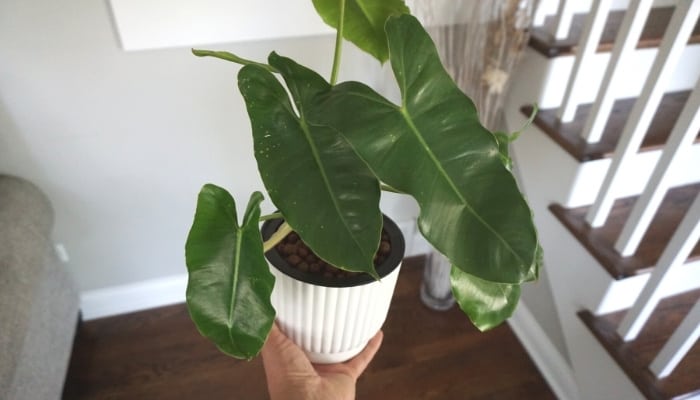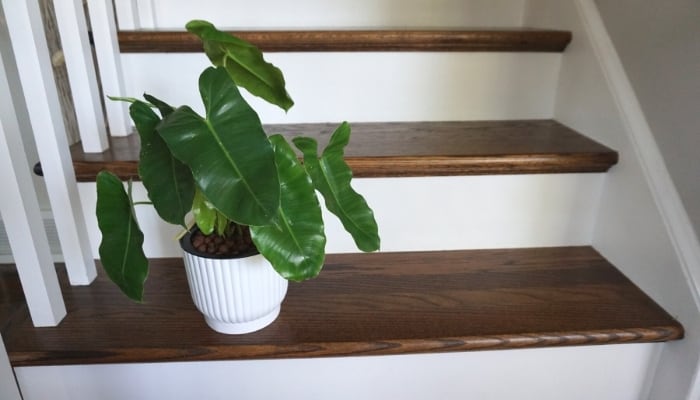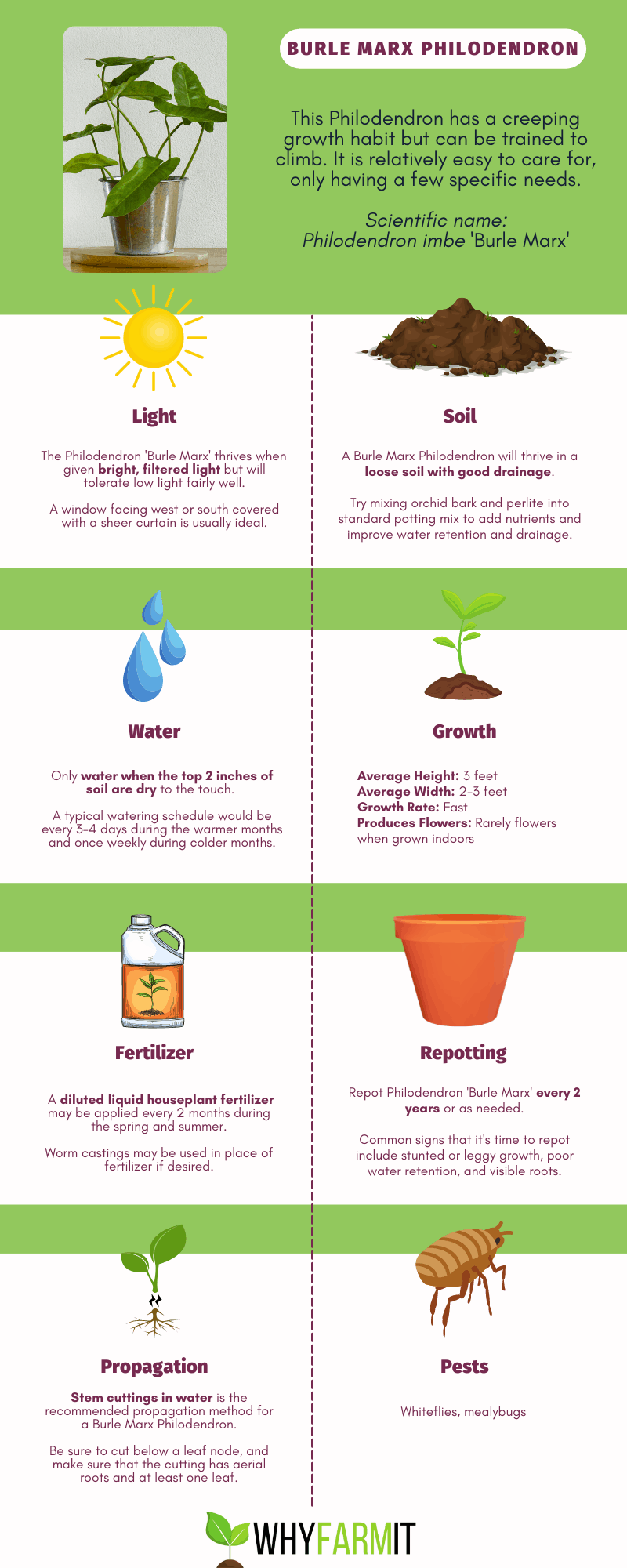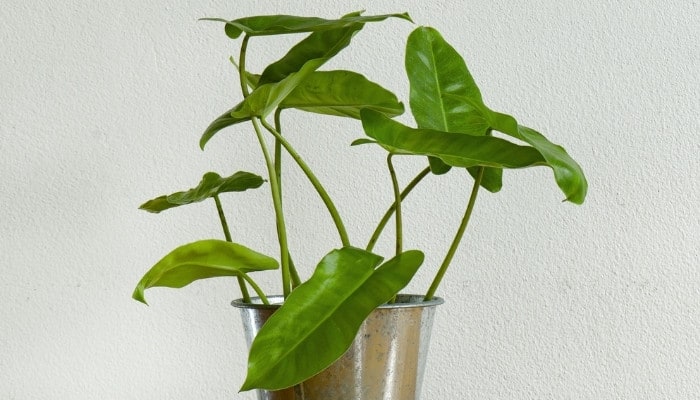If you encounter any difficulties while rephrasing the following text, please respond with the error message: Unable to process the request due to encountered difficulties.
This favored houseplant brings a touch of the tropical jungle inside with its glossy emerald-green paddle-shaped leaves, which cluster together to create a lush, bushy shrub.
As natural tree climbers, they will also favor creeping growth. What’s more, this striking variety is easy-going, but will flourish with a little effort.
How do you care for Burle Marx Philodendron? Plant Burle Marx in a light soil with good drainage. Place the plant in a location with bright, filtered light, keep temperatures between 64 and 79°F, and maintain more than 50% humidity. Only water when the top 2 inches of soil is dry, and fertilize every 2 months during spring and summer.
Caring for Burle Marx Philodendron: Basic Guidelines
The Burle Marx Philodendron is resilient and will tolerate some degree of neglect, but failing to keep on top of its watering schedule or leaving it in too bright light can run the risk of damaged and diseased foliage.
Keep this plant happy by meeting its ideal care conditions that you’ll find outlined below, along with guides on how to repot, deal with pests, and more.
Complete Care Guide for Burle Marx Philodendron
This houseplant is named after renowned Brazilian landscape architect Roberto Burle Marx who was credited with being the first architect to bring indigenous plants into modern landscape design.
Marx celebrated Philodendrons in his many gardens and park designs throughout the 1930s to reimagine native plants in a contemporary setting, prompting a trend for homeowners the world over to do the same with this elegant, undemanding plant.
Burle Marx Philodendron at a Glance
- Plant Type: Evergreen perennial
- Scientific Name: Philodendron imbe ‘Burle Marx’
- Average Height: 3 feet
- Average Width: 2-3 feet
- Growth Rate: Fast
- Produces Flowers: No
- Common Pests: Whiteflies, mealybugs
- Life Expectancy: Several years with good care
- Difficulty of Care: Low
What To Do When You First Get Your Burle Marx Philodendron
- Check for potential pests – This plant isn’t troubled often by bugs, but it’s always best to check any houseplant you bring home. Wipe away any sticky residue you find on the leaves with a damp cloth (see our Common Pests section for further advice).
- Give it a drink – Your Burle Marx will do best when kept in moist soil, so check the top 2 inches with your finger to see if it feels dry and could benefit from watering. If it is still damp, check back the next day to prevent overwatering.
- Find a suitable space – These plants tolerate many light conditions but not direct sunlight and complete shade, so pick an area of bright, diffused light in your home (north-facing windows will be perfect).
Ideal Soil for Burle Marx Philodendron
A light, mostly organic soil medium will be best to keep things airy while retaining moisture.
Author of The Contented Plant blog Kayti Lavergne recommends a nutritious, well-draining soil recipe of:
“potting soil, orchid bark, and perlite (granular material made from volcanic rock) to keep the roots happiest.”
Burle Marx Philodendron Water Requirements
Water this plant every 3-4 days over summer to ensure the soil doesn’t dry out and once weekly over the colder months.
Because the recommended soil will hold onto moisture, this plant can be left to dry between watering, and you should only give it a drink once you feel that the top 2 inches are no longer damp.
Burle Marx Philodendron Lighting Needs
Bright, dappled light will perfectly mimic its partial shade in the Brazilian rain forests, so filtered sunlight from a west- or south-facing window fitted with sheer curtains or blinds will be ideal.
Don’t worry if you can’t provide it with enough bright light in your area as it is tolerant of low-light conditions, though perhaps look into using an artificial grow light during winter.
This one is affordable, features three modes, and comes with a temperature/humidity monitor as a bonus.

Ideal Temperature Range for Burle Marx Philodendron
Temperatures between 64 and 79°F (18-26°C) are ideal for keeping your Philodendron ‘Burle Marx’ in the tropical range it is accustomed to, although it can tolerate slightly lower temperatures.
Just be sure not to let things drop below 50°F to avoid frost, and keep it well away from drafty spaces or AC fans.
Ideal Humidity Level for Burle Marx Philodendron
Humidity levels of 70-80% are perfect for recreating its rain forest conditions though this plant can cope well at around 50% humidity.
Depending on your home setting, a humidifier may or may not be necessary.
Sydney-based plant hobbyist Jess of JessyPotPlants on YouTube recommends “misting its leaves over summer to give it a little extra TLC as the air gets drier.”
If you find that your home’s air stays relatively dry and misting isn’t quite enough, definitely invest in a small humidifier to place near your plant.
I recommend this one – it’s ultra-quiet, doubles as a nightlight, and holds 1.5 liters of water so you don’t have to refill it often.
Best Location for Burle Marx Philodendron
Steamy and reasonably bright areas such as the bathroom or kitchen will be perfect, but as a partial-shade happy plant, a low-lit office or bedroom will suit it fine as long as you can meet its humidity needs.
Burle Marx Philodendron Growth Habits
This plant is a low-growing shrub with a natural inclination to creep vertically using its aerial (above-ground) roots to attach to nearby trees in its rain forest habitat.
As it grows taller, use a supporting pole to provide a support for the aerial roots to wrap around.
Fertilization Type & Schedule for Burle Marx Philodendron
Burle Marx Philodendrons are capable growers without feeding, but if you want to see fuller, quicker growth, you can use liquid fertilizer once every 2 months between spring and the end of summer.
Always dilute liquid fertilizer strength by half to prevent root damage, and note that this plant won’t need fertilizer throughout winter during its dormant period.
As an alternative to commercial fertilizer, you could use worm castings (earthworm waste) as a nutrient-rich organic fertilizer.
Apply on the same schedule as you would a liquid fertilizer.
Signs of Nutrient Deficiency
Leaves that are brown, yellow, or have wilted point to nutrient deficiency through over/underwatering.
Overly dry soil will starve the roots while a soggy environment can bring about rot, so you simply need to find a good balance by checking the top soil layer each day to ensure it stays moist.
Pruning Burle Marx Philodendron
If you wish to grow your Burle Marx in a compact bushy form you can prune back leaves that become tall and leggy with sterilized pruning shears.
Be sure to cut just above the leaf node or “bump” on the stem where new growth appears.
If you prefer this plant to creep upwards, however, simply prune leaves that have discolored with age.
Does Burle Marx Philodendron Produce Flowers?
Mature plants can produce reddish-purple spathes (modified petal-like leaves) but this is a very rare occurrence in indoor houseplants, which are primarily grown for their statement foliage.
Is Burle Marx Philodendron Toxic?
This plant is toxic to pets and humans, according to the National Garden Association.
All parts of the plant contain calcium oxalate crystals that can cause oral pain, swelling, difficulty swallowing, and vomiting if ingested.
Burle Marx Philodendron Propagation
As your Burle Marx Philodendron grows in size, a good way to control it (and multiply your collection at the same time) is to propagate or create new baby philodendrons from the mother plant.
Taking stem cuttings is widely recommended as the most fuss-free propagation method.
1. Cut a 3-6 inch Stem Section With at Least One Mature Leaf
Using clean pruning shears, cut a 3-6 inch long stem section about 1 inch below a leaf node.
The stem cutting should have some healthy aerial roots growing from the side of the stem and at least one mature leaf attached.
Roots should be fairly pale and feel firm, not black or mushy as this indicates rot.
2. Place Stem Cutting in Clear Vase of Tap Water, Submerging Aerial Roots
Before cutting, fill a small clear vase or jam jar with tap water and let it sit out for 24 hours to allow any chlorine to evaporate in order to give your cutting the best chance to develop.
Place the cutting in the water, ensuring the aerial roots are submerged, and put the jar in indirect sunlight. Change the water every 3-4 days.
3. Once the Cutting Develops Roots, Plant in Fresh Soil & Care for as Normal
After about a month, healthy new roots should develop at the base of your stem cutting.
Once the roots measure at least 2 inches long, it’s time to plant your stem cutting into a pot of its own.
Fill a small pot halfway with your ideal soil recipe, and plant your new stem cutting before filling the pot with soil and watering it well.
Check that the soil drains well, and find a suitably humid, bright place for your new Burle Marx offspring plant to thrive.
Repotting Burle Marx Philodendron
As a fairly fast-growing plant, your Burle Marx Philodendron will need to be rehomed every once in a while to accommodate its development and give it a break from tired, old soil.
When To Repot Burle Marx Philodendron
You should ideally repot this plant every 2 years, making sure to do so by late winter/early spring to place it in fresh, healthy soil before new growth comes in.
Every couple of years, the roots of your Burle Marx will start to overwhelm the pot, and the plant itself may start to appear leggy under the weight of the leaves, requiring a larger pot to accommodate a support pole.
Signs That It’s Time To Repot
- Roots are overwhelming the soil and appearing through drainage holes
- Stems have become tall and leggy (in need of a support pole)
- Current soil medium no longer drains or holds moisture well
How To Repot Burle Marx Philodendron
1. Prepare a Pot 2 Inches Larger Than Your Current One With Fresh Soil
Take a pot at least 2 inches larger in diameter than your current one and clean it thoroughly.
Fill it about halfway with a fresh soil mix, keeping to the ideal 1:1:1 ratio of potting soil, bark, and perlite.
As your plant will now be considerably taller, you’ll also want to consider purchasing a moss pole (like this one that grows with your plant) to support its creeping growth.
2. Remove Plant From Old Pot & Examine Its Root Health
Slide the plant out from its existing container and gently begin breaking the soil apart to expose the roots.
Quickly check on the health of the roots before repotting into new soil.
If any sections are black and mushy, these should be trimmed off with a sharp clean knife. Entirely rotten roots sadly cannot be saved.
3. Re-Plant Burle Marx Into Its New Larger Pot & Water Thoroughly
So long as healthy roots remain, you can now replant your Burle Marx into its new pot, along with its supportive pole if this is how you’d prefer it to grow.
Top off the pot with your soil mix and pat down lightly to secure it in place. Water it well, and place it in a suitably humid and well-lit area.
Burle Marx Philodendron Common Problems & Solutions That Work
Burle Marx Philodendron Common Pests
Thankfully pest problems are a rare occurrence with this plant, but if you do let its care regimen slide from time to time, you may come across these sap-sucking nuisances:
Whiteflies
- Signs of Trouble – Triangular white-winged bugs or sticky honeydew-like residue on leaves.
- Solution – Indoor garden enthusiast Melvin of Unica Plants recommends spraying the affected leaves with an “organic pesticide made with cold-pressed neem oil as this kills the current infestation on impact and polishes your leaves nicely too!” Try this organic neem oil.
- Prevention – Review current humidity as higher levels attract these pests. Also place sticky traps (like these cute yellow ones) near your plant.
Mealybugs
- Signs of Trouble – White, furry woodlice gathered in cotton-wool-like clumps and sticky residue on foliage.
- Solution – Tap them off the plant using a stick or apply a cotton swab dipped in rubbing alcohol to the affected area to dissolve them.
- Prevention – Reassess your watering frequency and humidity levels.
Burle Marx Philodendron Common Diseases
This plant is tough to kill, but with enough neglect or a poor routine when it comes to your watering habits, a couple of conditions can set in which severely affect its health.
Root Rot
- Signs of Trouble – Black, squishy roots, discolored foliage.
- Solution – Trim off affected areas with a sharp sterile knife, and repot plant in fresh soil.
- Prevention – Cut back on water frequency, ensure your soil mix has good drainage components to aerate the soil such as perlite, bark, and mulch.
Leaf Spot Fungus
- Signs of Trouble – Yellow water-soaked spots with dark-brown rings.
- Solution – Prune back affected leaves at first sign, and treat other leaves with a copper-based fungicide (this organic spray comes ready to use) to prevent further spores from germinating.
- Prevention – Do your best to maintain ideal humidity conditions, and keep soil moist but not soggy as fungal spores in the air love a wet and warm environment.
Other Common Problems
Overly eager care with this low-maintenance plant can often do more harm than good, so try not to stray from the ideal environmental conditions to avoid the following:
Browning Foliage
- Signs of Trouble – Brown edges and tips of leaves
- Solution – Trim affected tips and leaf margins in line with its natural shape using clean pruning shears.
- Prevention – Don’t over-fertilize as salt residue can hinder root health, and check soil regularly to determine balanced watering schedule (neither too dry nor saturated).
Yellowing Foliage
- Signs of Trouble – Yellow or pale-colored leaves.
- Solution – Prune back affected leaves, and wait for the top 2 inches of soil to fully dry before watering again.
- Prevention – Review your plant location as yellow, pale leaves can indicate too much sunlight. Overwatering also plays a role, so check the soil regularly to get a feel for when it truly needs watering.
Burle Marx Philodendron Common Questions

How Much Does a Burle Marx Philodendron Cost?
The original Burle Marx Philodendron plant can cost between $50-80 for a full, mature plant or around $15 for a single stem cutting.
Cultivars of the original Burle Marx variety can cost more due to their bolder green or variegated foliage pattern.
Is Philodendron Burle Marx Rare?
The original Philodendron ‘Burle Marx’ plant is easy to source and affordable, so it is not considered rare.
According to hobbyists on the UBC Botanical Garden forum, the original was “once so extremely popular in landscaping and collections that it fell out of favor as too common.”
Is Philodendron Burle Marx a Hybrid?
The Philodendron Burle Marx is listed among the 450 plus varieties within the Philodendron plant genus, but some enthusiasts have argued that its true taxonomy could be incorrect since R. Burle Marx himself was known to experiment with cross-pollination.
How Big Do Philodendron Burle Marx Get?
This plant can grow to heights of around 10 feet tall in the wild with the leaves measuring 3 feet in length.
As a houseplant, Philodendron ‘Burle Marx’ has a typical indoor growth of about 2 feet tall or more with good care with a 3-foot spread of leaves measuring 20 centimeters (0.6 feet) each.
Why Is My Philodendron Burle Marx Drooping?
Drooping indicates that your Burle Marx is underwatered, causing the leaves to wilt and become limp to preserve its resources.
Give your plant a thorough watering, and perform a finger check in the top 2 inches of soil each day afterward to ensure the top layer does not remain dry for too long.
How Do You Care for Philodendron Burle Marx Fantasy?
As variegated plants contain less chlorophyll, the Philodendron Burle Marx ‘Fantasy’ hybrid needs carefully filtered light (40% cover with a sheer curtain) and a consistent temperature range to preserve its patterned foliage.
Maintain a climate of 55-80°F and 70% humidity with regular misting and draft control, and water the plant weekly.
What Is Philodendron Burle Marx Variegata?
Philodendron ‘Burle Marx Variegata’ is an uncommon variety cultivated from Philodendron ‘Burle Marx’ and features glossy variegated leaves of dark green splashed with white and lighter green shades.
It develops in a compact bushy shape but can be trained to climb and can tolerate low light.
What Is Philodendron Burle Marx Albo Variegata?
The Philodendron ‘Burle Marx Albo Variegata’ is a rare cultivar of the Philodendron ‘Burle Marx Variegata’ featuring heavy variegation in its leaves that range from all yellow, green, and cream colors to striped green with pink mottling.
This variety thrives best in rich, organic soil, and mature plants can cost upwards of $300.
Burle Marx Philodendron vs. Green Emerald
Green Emerald Philodendrons or Philodendron erubescens have similarly rich-green leaves that hang down, but these are fuller spade-shaped leaves with more pronounced veination compared to Burle Marx.
They can grow larger, reaching 4 feet plus and require twice-weekly fertilizer during summer.
3 Key Tips for Success With Burle Marx Philodendron
1. Feel the Soil Routinely Until You Find Its Watering “Sweet Spot”
Striking the balance between over/underwatering can be tricky at first, but doing a daily checkup to see how long the soil stays moist and when it’s likely to dry will help you predict its watering timetable – leaving you to focus on other aspects of its care.
2. Go Light on the Fertilizer & Remove Soil Impurities
As the Burle Marx Philodendron isn’t overly reliant on fertilizer to do well, hold off when growth is healthy.
Fertilizer leaves salt deposits behind in the soil which can harm the roots over time by feeding chlorine to them in place of nutrients.
Flush this buildup out of the soil once every 6 months by running your plant under lukewarm water.
3. Use Humidity Hacks To Mimic Its Ideal Environment
Though it can cope with humidity levels of 50%, you’ll enjoy your beautiful Burle Marx plant for longer if you can hitch up the humidity to tropical levels using a humidifier.
You can also employ humidity hacks such as setting up a pebble tray, growing them under a glass cloche, and giving the leaves a daily morning mist.
Use a humidity monitor (like this one that updates every 10 seconds) to help you keep track!
Conclusion
In summary, the Burle Marx Philodendron has the winning combo of elegant looks with low-maintenance care, making it perfect for confident beginner plant keepers.
Its tolerance for low lighting will suit it to many areas of the home and milder climates, but you will get the best out of this vibrant, tropical stunner if you make the effort to cater closely to its native conditions.


